EDITOR’S NOTE: With Bike Everywhere Day a week away, Seattle Neighborhood Greenways has some ideas for how you can get engaged to help get the downtown Basic Bike Network back on track. If nothing else, scroll to the bottom to see their action items. This is a cross-post from their blog.
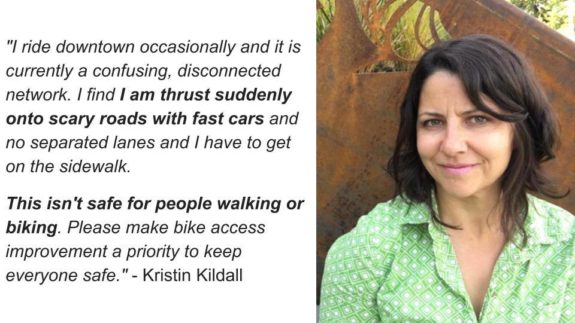 May is National Bike Month. A month when everyone is encouraged to dust off their bike, pump up their tires and try biking to get to work, school, local businesses, or just for fun. Everyone who wants to bike should be able to because biking can make us happier, keep us healthier, save us money, and reduce pollution.
May is National Bike Month. A month when everyone is encouraged to dust off their bike, pump up their tires and try biking to get to work, school, local businesses, or just for fun. Everyone who wants to bike should be able to because biking can make us happier, keep us healthier, save us money, and reduce pollution.
But right now, too many people find biking to where they want to go scary or uncomfortable. In fact, a lack of safe streets is the number one reason people in Seattle don’t bike more.
It doesn’t have to be this way.
Way more people bike in cities that have safe, comfortable, and convenient bike networks. Around the world, cities like Vancouver, Calgary, New York and London have all implemented connected bike networks and seen ridership exploded. Even here in Seattle, when the 2nd Ave protected bike lanes were connected to Pike and Pine, ridership jumped 30% on 2nd Ave. But we still have a long way to go in Seattle.
That’s why we created a vision of a bike network that connects all neighborhoods, starting with our fastest growing “Urban Villages.”
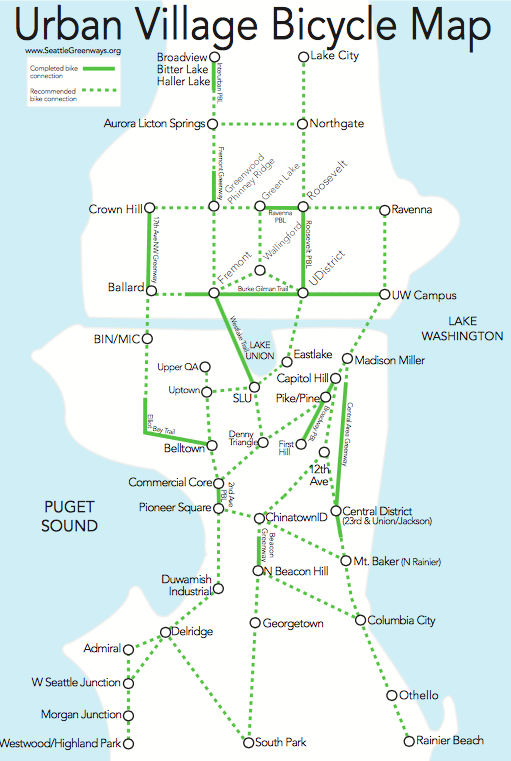 And collaborating with Cascade Bicycle Club, we also created a plan for a “Basic Bike Network” for downtown Seattle.
And collaborating with Cascade Bicycle Club, we also created a plan for a “Basic Bike Network” for downtown Seattle.
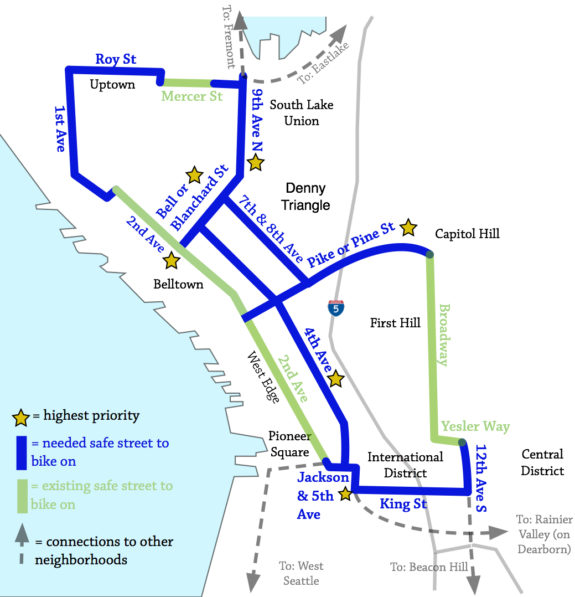 Unfortunately, in 2016, former Mayor Ed Murray put the Basic Bike Network on hold until after a new transportation plan for downtown Seattle called One Center City could be developed.
Unfortunately, in 2016, former Mayor Ed Murray put the Basic Bike Network on hold until after a new transportation plan for downtown Seattle called One Center City could be developed.
We pushed back against these delays. Led by family bikers, we filled City Hall holding signs saying “My Family Bikes” and “Safe Streets Now,” chanting “We can’t wait!” As a result of these protests, the city promised to build parts of bike lanes on 2nd Ave and Pike/Pine and include bike routes in the One Center City planning process.
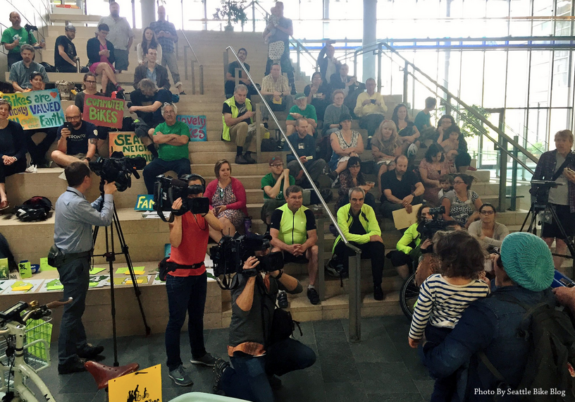 The two-year One Center City (OCC) collaborative planning process resulted in a plan for downtown that safely moved more people. The planning process was organized by a working group made up of government, agency, and dozens of community stakeholders. Last fall, after years of study, analysis, and compromise, the committee approved a holistic plan that would keep everyone moving downtown. The plan included new bike and bus lanes that would increase safety (decreasing collisions by seven to 18 percent), move more people with more efficiency (10,000 more people per hour), and reduce travel times for everyone (30 seconds to one minute compared to the no-action alternative). Additionally, the city’s analysis showed that the Basic Bike Network was a key part of the solution, because by building it the number of people biking downtown would double by 2023.
The two-year One Center City (OCC) collaborative planning process resulted in a plan for downtown that safely moved more people. The planning process was organized by a working group made up of government, agency, and dozens of community stakeholders. Last fall, after years of study, analysis, and compromise, the committee approved a holistic plan that would keep everyone moving downtown. The plan included new bike and bus lanes that would increase safety (decreasing collisions by seven to 18 percent), move more people with more efficiency (10,000 more people per hour), and reduce travel times for everyone (30 seconds to one minute compared to the no-action alternative). Additionally, the city’s analysis showed that the Basic Bike Network was a key part of the solution, because by building it the number of people biking downtown would double by 2023.
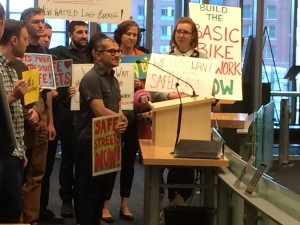 But when the new Durkan administration came to power, they pushed aside the One Center City community stakeholder committee, ditched the compromise, delayed the bike lanes, and watered down the transit improvements. So we rallied caring community members who were fed up with all the delays and sent hundreds of emails to elected leaders and testified at City Council meetings.
But when the new Durkan administration came to power, they pushed aside the One Center City community stakeholder committee, ditched the compromise, delayed the bike lanes, and watered down the transit improvements. So we rallied caring community members who were fed up with all the delays and sent hundreds of emails to elected leaders and testified at City Council meetings.
While we haven’t won yet, our elected leaders are listening now. Help us keep the momentum going.
Here are three quick things you can can do during Bike Month to make the Basic Bike Network a reality:
- Show up at the Rally for the Basic Bike Network on Bike Everywhere Day, May 18. Gather at 8:00, program 8:15 – 8:45 AM at the Seattle City Hall Plaza.
- Share a photo of yourself along with a quote about why a basic bike network is important to you. Check out our inspiring album on Facebook and share your own story with tags #basicbikenetwork, #wecantwait, and #seattlegreenways.
- Ride your bike & bring a friend! There is safety in numbers – research has shown the more people who ride their bikes, the safer everyone is. May is a great time to encourage a friend, colleague, or family member to try biking in Seattle.
Bonus action: Become a monthly donor. Seattle Neighborhood Greenways is a 501(c)3 and we depend on your financial support to make every neighborhood a great place to walk, bike, and live.
Thank you!








Comments
11 responses to “Seattle Neighborhood Greenways: Save the Basic Bike Network”
I have a question. What do readers think of the Neighborhood Greenways?
I don’t like them. They are indirect routes, that zig-zag through neighborhoods. Parked cars and narrow streets limit sight lines. Drivers often disregard greenway stop signs, and drivers can’t see past trees, parked cars, or around corners to see cyclists coming. Traffic circles, also block sight lines. Some greenways are so narrow that a car and a cyclist going opposite directions can hardly pass each other. Pavement is cracked, broken and often not suitable for bike riding.
A proper greenway would have clear sight lines. Parking removed from at least one side of the road. Lines painted on the street as a permanent and constant reminder to drivers that it is a cycle path. They would have direct routes (a difficulty with Seattle’s broken street grid).
It’s a shame that cyclists are being forced into the shadows, out of sight, out of mind.
I think they are certainly not a replacement for a proper bike network, but they are useful in addition. I think Vancouver is a good example of that model where they have both good bikeways and greenways.
Seattle Neighborhood Greenways advocates for both approaches.
The difference in Vancouver is that they combine both into a coherent network that solves the city’s greatest transportation problems, in particular, transportation to and around downtown.
In Seattle, greenways are just an excuse for SDOT to burn taxpayer money and claim they’ve built bike infrastructure, while hiding it neatly out-of-the-way where few people actually need or ride it.
It sounds nice and cute to build roads from low-density suburban neighborhoods to local parks and the like, but really, how many days a week do you need to make a bike trip to Volunteer Park? And why would you bike when there’s ample parking and it’s faster and easier to drive?
as Dave said, be careful not to confuse Seattle Neighborhood Greenways (the excellent safe-streets advocacy group based on localized community subgroups), and “greenways,” which are SDOT’s often poor implementation of a side-street bicycle route.
The greenways serve a purpose, but they are often poorly implemented and overused. They are a great way to bike slowly (either because you’re going up a steep hill or because you have kids with you, or you just want to) without cars zooming by at 30 mph. I personally like that I can ride home on one while chatting with my wife. That said, when they cross arterials it’s usually a game of “frogger,” and the lack of diverters means that I still have frequent near-misses with aggressive/inattentive drivers. Your issues with traffic circles and sight lines are very valid, but (as you suggest) are a problem with implementation and not with the principle. They are most certainly not a substitute for arterial bike lanes, but many times the city builds them because they’re much cheaper and more politically expedient. The way that NE 65th street jogs to a greenway on 68th in the BMP is a perfect example of this.
For a great run-down on the philosophy of how all the various parts of the bike network are envisioned, I strongly encourage reading the first dozen or so pages of the Bike Master Plan. It’s extremely well done.
https://www.seattle.gov/Documents/Departments/SDOT/About/DocumentLibrary/BicycleMasterPlan/SBMP_21March_FINAL_full%20doc.pdf
“Orange Wheels” says that “greenways … are often poorly implemented and overused.” I agree with the first part, but my observation is that the greenways in my area are mostly not used at all. I rarely see a cyclist on the 12th Ave. NE greenway or on the NE 39th St. greenway, or on the Wallingford greenway.
So they spend years coming up with One Centre City plan, then they effectively cancel all of it. So absurd it’s almost funny.
I guess they’re too busy wasting your and my taxpayer money on a redundant central district greenway, that’s 5 blocks away from the one nobody bikes on anyway?
(Total aside, I strongly recommend Carlton Reid’s book “Bike Boom”, which goes through case studies that eviscerate the argument that “if you build bike infrastructure, people will use it”. One can easily predict the failure of most of Seattle’s greenways, including this one, through his arguments.)
my criticism of the map is please replace the Central Greenway solid green line with the MLK PBL dashed green line. Let’s not forget that this was planned to be built in 2017 and could be a much better connection for cyclists than the greenway is
It’d be great if this Urban Village Bike Map was implemented.
One connection to add to the map is the Georgetown–Othello connection which should be almost complete after the Swift Avenue S / S Myrtle Street / S Othello Street Paving Project is complete.
“Orange Wheels” says that “greenways … are often poorly implemented and overused.” I agree with the first part, but my observation is that the greenways in my area are mostly not used at all. I rarely see a cyclist on the 12th Ave. NE greenway or on the NE 39th St. greenway, or on the Wallingford greenway.
[…] The effort has been adopted by and entangled in City Hall’s downtown transportation planning process. And now, under Mayor Jenny Durkan, advocates say the plan is being pushed aside: […]